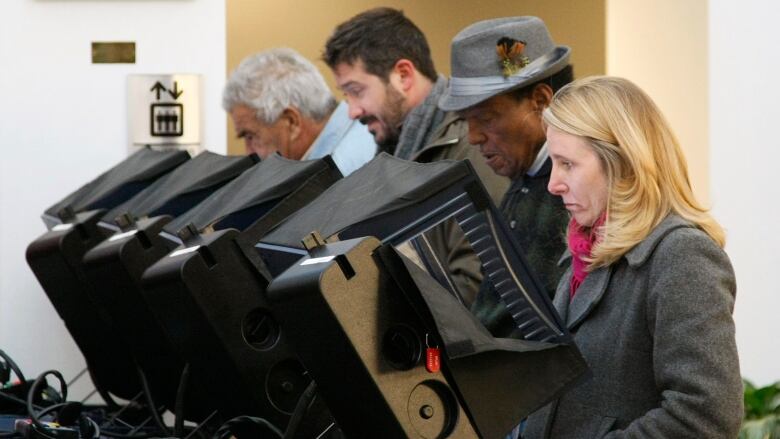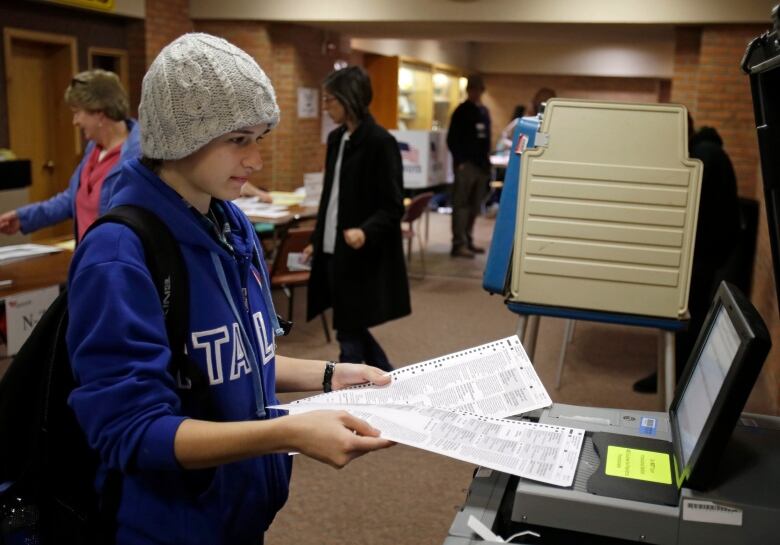U.S. presidential election uses hodge-podge of voting technology
From filling in bubbles to all-electronic devices, Americans have many ways to vote

When Americans go the polls on Nov.8, they'll be casting votes using a wide array of technology, from touchscreens to pen and paper.
In light of Donald Trump's claims of election fraud and with the memory of the disputed presidential election of 2000 still looming that technology could be under more scrutiny than ever in this year's presidential election.
Here's a look at the different ways Americans will make their choices:
Ballot scanning
Familiar to anyone who's taken a standardized test, the scanning method requires voters to mark a specific area, such as filling in a bubble. The ballots are then tabulated by a scanner, using either optical equipment or digital scanning technology.

Counting ballots with scanners is the most widely-used method of voting in the U.S., "and has been for a very long time," saysPamela Smith, president of Verified Voting, a U.S. non-profit that advocates for accurate, transparentand verifiable elections.
"Any electronic system can be tampered with," says Smith. "But the benefit of having a scanner is that you maintain the ballot" for auditing later, if necessary.
Electronic systems
These ATM-like devices, known in election-industry parlance as "direct recording electronic" systems, enable votingbytouchscreen, buttonor dial. The machines tabulate votes automatically, helping to speed up the voting process unless technical difficulties strike.
"If more than one [machine] breaks down, then you're stuck with emergency paper ballots," explains Smith. "Then you start running out."
The flexibility of electronic systems can be useful in areas where voters speak multiple languages, and can also help disabled voters through the process. Still, not all direct recording electronic systems print paper receipts of the votes cast, creating a potential lack of accountability.

Then there's the question of security: Although Smith says the vast majority of electronic voting machines don't have any kind of network connectivity, an enterprising hacker with the right access could still tamper with the voting process.
Plus, the technology inside many electronic voting machines in the U.S. is far from cutting-edge.
Many were designed in the late 1990s "using laptop technology from that era," saysLawrence Norden, deputy director of the Brennan Center for Justice at NYU, and lead author of a 2015 report on aging voting machines. That report estimates it would cost about $1B USto replace aging voting equipment across the country.
"While Apple can produce millions and millions of iPads and therefore charge less per iPad, there are only 10,000 voting jurisdictions in the U.S., and even if they're replacing machines every ten years, you can't really scale that up to a point where you can manufacture that more cheaply," says Norden.
Ballot marking devices
These devices combine the accessibility of electronic systems with the accountability of paper ballots. Voters make their choice via a touchscreen or other interface, but the machine records the vote by marking a physical ballot. Unlike all-electronic systems, votes are tabulated separately by hand or scanner.

Although ballot marking devices are often used as accessibility devices for marking scannable paper ballots, Smith believes the tools are gaining interest from elections officials as a standard method for casting votes.
"A lot of elections officials really like the idea of voters doing a better job of marking their paper ballots," says Smith.
In fact, Los Angeles liked the idea so much that it worked with a design firm to create its own touchscreen ballot marking devices, which print completed ballots for voters to check before submitting them. Those machines won't be available for the upcoming election, though.
Punch cards

Punch card machines let voters punch holes next to their choice on a paper ballot. Even though punch cards do leave a paper trail, Pamela Smith of Verified Voting says punched ballots are difficult to audit.
"Punch cards were great in one way, in that they were extremely inexpensive," allows Smith, but they've "fallen out of favour"across the U.S. since the debacle of the 2000 presidential election in Florida.
In that remarkably close race, incompletely punched holes called "chads" and other irregularities led to confusion about voters' choices, complicating a politically fraught recount and undermining faith in the election process.
Hand-counted paper ballots
Some U.S. jurisdictions count ballots by hand, in addition to using technology.
"I want to know for certain that the scanners counted accurately," says Virginia Martin, Democratic election commissioner for Columbia County, NY, where hand-counting is standard practice. (The county doesn't hand-count 100 per cent of votes in every election, making exceptions in cases such asuncontested local races).
Martin anticipates that about 25,000 people will vote in her county in November's election,and says counting the ballots and verifying the results from the scanning machineswill take about a week.
"We've been doing it since 2010, and we've gotten pretty good at it," says Martin.
Online voting
Although online voting might be the holy grail of technologically-enabled democracy, experts agree that it would be all but impossible to make the process secure. Still, some states do allow online voting in certain circumstances.
Alaska, for example, allows any registered voter to apply for an electronic ballot and fill out a PDF file with their choices, sign an identification certificate in the presence of a witness, and return the documents online through a "secure delivery system."
However, Alaska warns voters that online voting waives their right to a secret ballot, and that the ballot may not be transmitted properly a reminder that secure online voting remains a dream for future elections.












_(720p).jpg)


 OFFICIAL HD MUSIC VIDEO.jpg)
.jpg)



























































































